Application of counting adjustment and equidistant counting adjustment and isometric sampling method in steel drum inspection
Liu Aiqu, Wang Yidian, Song Zhichao
Preface
The counting adjustment type sampling inspection scheme is a sampling method commonly used in the world. It is a kind of adjustment of the degree of lenient according to the actual changes in product quality, and minimizes two types of misjudgments (ie, misreceived: unqualified mistakes, judged as qualified, received. Mistaken: misjudged as not The sampling plan with the probability of being qualified and not accepted is generally applicable to large-scale continuous production occasions, and is particularly suitable for continuous multi-batch production with total quality management.
The isometric sampling program is also called mechanical sampling or systematic sampling. It is to pre-arrange all the units (or products) in the survey population (note: the whole of the research object) in a certain order, and then mechanically extract the samples at regular intervals (Note: it is random from the population) A sampled method of conducting a survey of a part of the product that was extracted and tested.
Combining these two schemes, it is scientific and effective to control, inspect and accept the quality of steel drums.
Proposal of the program
There are more than 100 steel drum production plants in China, with an annual output of more than 30 million steel drums and an annual output value of more than 600 million yuan. Steel drum is a kind of packaging. It is widely used in industries, agriculture, national defense, foreign trade, food and other sectors, and plays an important role in socialist construction. Steel drum manufacturing generally has to go through blanking, stamping, coiling, seam welding, ribbing, crimping, pressure testing and other processes. Steel drum production is generally produced in a large batch with a high degree of mechanization.
At present, due to raw materials, equipment, management and other reasons, the quality of steel drums in China is not very stable. The quality of products of most manufacturers has not yet met the requirements stipulated in the International Maritime Dangerous Goods Transportation Regulations. There is still a big gap between the barrel factories in developed countries and the world. Therefore, how to stabilize product quality and improve the quality of steel drums has become a problem that must be carefully studied and solved. We believe that the cause of unstable steel drum quality, in addition to raw materials, equipment, processes, etc., steel drum production process can not be controlled is an important reason. In recent years, according to the characteristics of steel drum production, we have designed a steel drum counting adjustment type and an isometric type sampling inspection program. Through the experiments in production, the production process has been supervised, and the detection and control have received good results.
Program characteristics
The counting adjustment type sampling plan has dynamic characteristics. For a certain product batch quality, instead of adopting a single solution, it adopts a set of different rigorous schemes (normal, rigorous, and relaxed) and links them with a set of conversion rules. In general, the normal inspection scheme is used, and when the inspection results indicate that the quality of the product is significantly deteriorated or the production is unstable, it is switched to the use of the tightened inspection scheme. These three schemes are converted according to the quality of the products, so as to achieve supervision and control of the steel drum production process.
The isometric sampling program is reliable and easy to use. In this method, since all the parts can be included in the sample to a certain extent, it is better to ensure that the extracted samples are evenly distributed in the whole, thereby improving the representativeness of the sample, and, since the steel drum production is generally continuous. Pipeline production, sample extraction is carried out at a certain production interval, therefore, the work of taking samples in the production process can also be carried out by the machine, which is convenient.
When the two schemes are combined to test the quality of the steel drum, the roles are different. The function of the adjusted sampling inspection program is to determine the number of samples and the number of samples to be tested according to the output of the steel drum or the number of stacking codes and the quality level of the steel drum. (Note: The number of unqualified products sampled is less than or equal to a certain number. Judging that the batch of products is qualified, it will be pulled. This number is called the receiving number. It is represented by the letter Ac and the distance is received. (Note: If the number of unqualified products is greater than or equal to a certain number, the batch is judged to be unqualified. , does not receive, this number is called the rejection number. It is represented by the letter Re, and is converted according to the (Table 2) conversion rules. The role of the isometric sampling program is to provide a method for sample extraction. Combining the two together to form a complete inspection program has great significance for the quality inspection of steel drums. First of all, these two schemes are based on the sampling characteristic curve, which conforms to the binomial distribution and the Pwson distribution. The sampling error is small and reliable, and it can be used to estimate the overall quality level. Secondly, due to the adjustment sampling scheme It includes a set of solutions that can be converted to each other, so it can be used not only for the acceptance of steel drums, but also for the production process of steel drums. Dynamic control and supervision; finally, because the number of samples can be determined without complicated formulas (direct lookup table 1), it is easy to use and easy to implement.
Therefore, it is scientific and simple to test and control the quality of steel drums by counting adjustment type and isometric sampling inspection scheme.
For example, our factory previously conducted a total of 18 tests on the finished products according to the “Quality Inspection Rules for 200-liter closed steel drums†of the Food Department of the Ministry of Commerce. Since the sampling is carried out after all the products are produced, it is equal to "the post-mortem autopsy" does not control the quality of the production process, and it is extremely inconvenient to carry out manual number sampling after the product is stacked. Using the "counting adjustment and equidistant sampling method", the product is electronically or mechanically counted (for example, the counting device of the Shanxi Hydraulic Machinery Factory crimping machine), which is randomly intercepted, convenient for sampling, and the inspection is carried out simultaneously with the production, product quality information. Timely feedback has played a role in supervising, controlling and ensuring the quality of the production process. At the same time, the quality of the product in the process is manually controlled and controlled, and the quality of the process product is also guaranteed.
Implementation of the plan
First, the steps
1. First determine the quality level of the steel drum and the quantity of the batch (parent). The general quality level can be based on the national standard of the product, the ministerial standard, the enterprise standard or the standard agreed by the user; the quantity of the batch (parent) is given by the large batch size and the sample size of the big leopard principle (Table 1). For example, the general quality level of our steel drum is 2.5% (non-conforming product rate), and the batch size is 151~280.
2. According to the batch (maternal) number and quality level check (Table 1), the number of samples (n), the number of acceptance (Ac), and the number of rejection (Re) of a normal, tightened, and relaxed scheme of a certain quality level are determined.
3. Samples are taken using an isometric sampling protocol
(1) All the stacked and flat steel drums are numbered from left to right (or from top to bottom, or in order). Make the same number of signatures based on the quantity produced in the steel drum and number them sequentially. If you sign one, you can take one (do not put it back). If the number is 97, the first steel drum is 97, and one is taken (not put back). If the number is 88, then the second. The number of barrels is number 88... and so on, all steel drums are numbered. The steel drums being produced may not be numbered, and the sample buckets are randomly intercepted according to the sampling distance.
(2) Calculate the distance of the sample to be extracted according to the formula h = N/n (where N is the formula, the number of the mother is the most. n is the number of samples. H is the sampling distance) and then the sample is taken according to the sampling distance. In the production process, qualified manufacturers can also mechanically count and mechanically sample by sampling distance.
4. The extracted samples are tested according to the steel drum quality inspection project. Determine the quality status and direction of the steel drums.
(1) First, judge whether the batch of steel drums is qualified or not. If the non-conforming product is less than or equal to the number of receipts, it is judged that the batch of products is qualified and accepted. If the non-conforming product is greater than or equal to the rejected number, the batch of steel drums is judged. Not qualified or undergo a full inspection.
(2) After several batches of steel drums are tested, they are converted according to the rules in (Table 2) to control the quality of the products in the production process.
Second, the example
Set a factory to produce steel drums per shift 诵 N = 250, the required quality level is AQL = 2.5%, try to develop a sampling plan for the batch of steel drums.
Steel drum adjustment type sampling plan (Table 1)
1. According to N = 250, AQL = 2.5%, check (Table 1) for sample capacity (n), number of acceptances (Ac), and number of rejections (Re). See (Table 3).
Steel drum counting adjustment and isometric sampling plan (Table 3)
Known batch N = 250, quality level AQL = 2.5%
That is to say, from the 250 steel drums in the class, under normal inspection conditions, the number of samples (Table 1) is n=32, the number of acceptances is Ac=2, the number of rejections is Re=3, and the sampling interval is h=8. One of the steel drums in production is pumped at intervals of eight. A total of 32 barrels were taken for testing. If the test result is within 2 or less, it is determined that the batch of barrels is qualified and accepted. If the test result is more than 3, the batch is judged to be unqualified, not accepted, and processed by the production workshop. Re-delivery inspection. Under the condition of relaxed inspection, when the number of non-conforming products sampled is 2, it exceeds the number of receptions 1 and the number of rejections 3, and it can be judged that the batch of steel drums is qualified, but in the next batch, it returns to the normal inspection, that is, Eligible for the condition.
2, after testing a number of barrels, the following table rules conversion, see (Table 2)
Steel drum sampling conversion rules (Table 2)
All of the following conditions are met:
1. It is qualified for six consecutive batches; 2. The production is stable; 3. The competent department considers it necessary.
One of the following conditions is met:
1. One batch is unqualified; 2. One batch is qualified; 3. The production is abnormal or stagnant; 4. The competent department considers it necessary.
Issues that need attention and research
First, the practical conditions of the program:
1. The production of steel drums must be continuous production line production, the larger the batch size, the better the practical effect.
2. Production must be in a stable state. This program cannot be used when the test, trial production, and production are not in a stable state.
3. Quality management personnel must have certain mathematical statistics and quality management qualities, and strengthen the overall quality management education for workers, emphasizing the three-level inspection system.
4. Key items of product quality are subject to inspection. For example, the steel drum leakage test should be inspected by the production workshop and the inspectors should take random inspections.
Second, the treatment of non-conforming products:
1. Disposal of unqualified batches: For the unqualified batches that have been tested and judged, in principle, they are returned to the production workshop, and after the unqualified products are picked out, the inspectors perform the sampling inspection according to the above methods. If the number of unqualified products is less than or equal to the number of receipts, the batch is considered to be qualified. If the number of unqualified products is still greater than or equal to the number of rejects, the batch is considered unqualified. And - requires the production workshop to conduct a full inspection.
2. Disposal of non-conforming products: The non-conforming products found during the inspection process shall be returned to the production workshop for repair, replacement, repair, and replacement of the products, and shall also be accepted before being accepted.
Third, the simplification of the detection items:
The workload of steel drum quality inspection is largely determined by the number of inspection items and the difficulty of inspection items. Therefore, strengthening process quality control and simplifying inspections have become issues that should be carefully studied.
1. Modification of GB325-84: The inspection items are determined according to product standards. GB325-84 has played an important role in guiding the production of barrels for several years, but many barrel mills have found some problems to be modified during implementation. For example, there are too many routine inspection items, the product grade is too strict, the inspection workload is large, and the paint film thickness and paint film adhesion are not easy to detect. The formulation of product standards must first meet the principle of improving product quality and facilitating implementation. Therefore, when modifying the standard, you should seriously consider the problem of simplifying the inspection items.
2. In the process of steel drum production, the quality inspection of each process and the inspection of finished products should be made of special work card measuring tools and tooling. For example, the test press, the tooling for ensuring the distance between the two holes, the blanking tooling, the threaded ring ring gauge, and the like.
In general, the “counting adjustment and isometric sampling program†is a scientific and simple method based on total quality management. It will play a certain role in promoting the quality level of steel drums and improving the scientific management level of steel drum production.
Magnetic Receptive Whiteboard Sheet
Magnetic Receptive Whiteboard Sheet is one kind of flexible whiteboard. It is easy cut, bent, twisted, coiled, or can machined into almost any shape. So it can be roll up to saving space and carry easily.
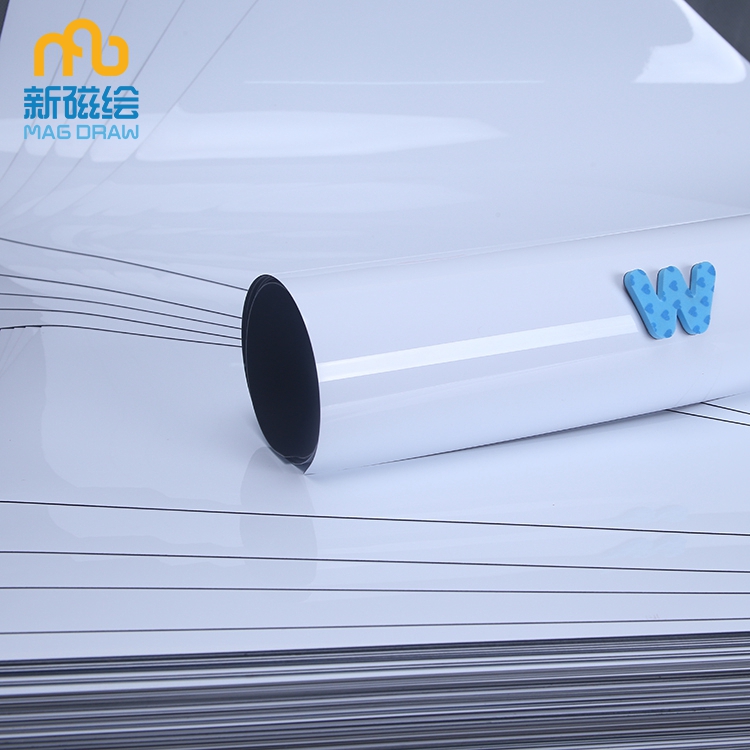
Excellent Write-on and Wipe-off Durability
Magnetic Receptive Whiteboard Sheet has excellent write-on and wipe-off durability. Premium PET base, good weather resistance. It is compatible for many kinds pen, like dry erased whiteboard marker, easy to write and wipe. For normal whiteboard marker pen, marks can be dry erased off within one month. If the marks leave on a whiteboard for long enough and can`t be dry erased, please use whiteboard cleaner or some alcoholic liquid to get them off.
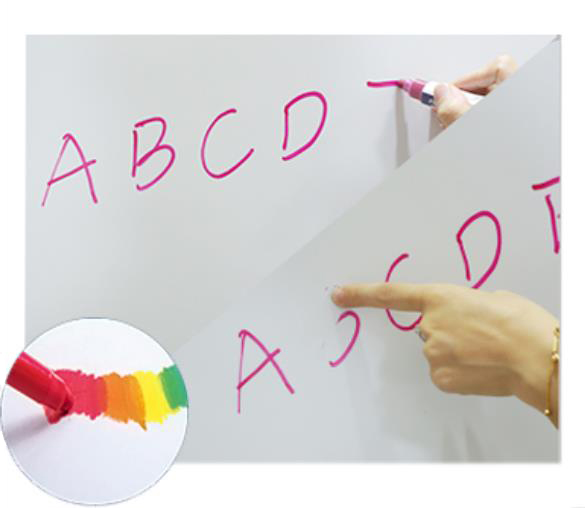
Many Creative Application
Magnetic Receptive Whiteboard Sheet is made of premium PET and steel sheeting. Steel sheeting is made by mixing iron powder with plastic (CPE etc.). It has excellent magnetic receptive ability. This whiteboard film is becoming increasing popular for the use as Whiteboard Wall or magnetic wall paper. This whiteboard sheet can be exchanged and / or replaced when applied to a wall that has a layer of our magnetic sheeting with adhesive. Restaurants, businesses, preschools and home owners can easily change their wall paper according to their mood, holiday, or season. Multiple layers can be applied to create attractive designs and decors. The versatility of this product creates many different decorating and advertising possibilities.

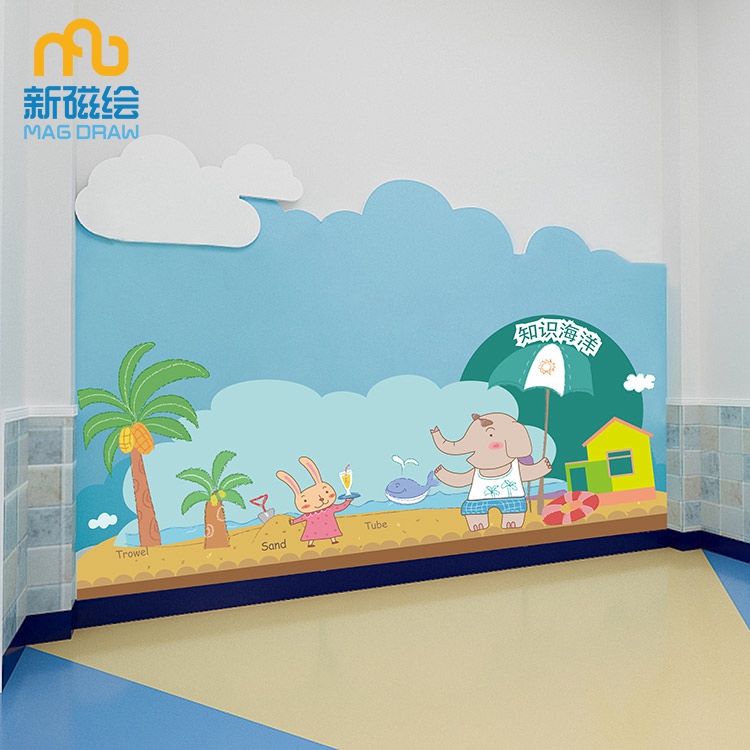


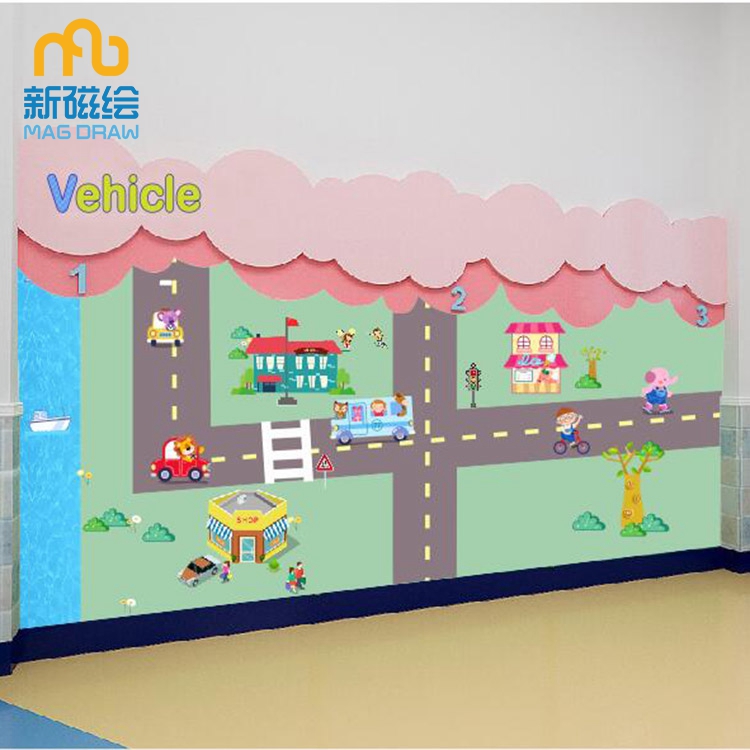

Three Kinds Whiteboard Sheet for Guest Needs
1.Self Adhesive Whiteboard is made of strong adhesive, so the Whiteboard Sticker easy to install and won't fall off easily. The steel sheeting of whiteboard has a certain thickness so that it does install with no wrinkles and no bubbles. No need to drill holes in you wall and can be install any smooth surface like desk,cabinet and so on. By the way,Magnetic Whiteboard Sheet is suitable to install on our Magnetic Receptive Whiteboard Sheet for replace the old Self Adhesive Whiteboard.
2.Removable Adhesive Whiteboard is made of high quality reusable adhesive, added removal for on-the-go mobility to the Self Adhesive Whiteboard. If the adhesive surface is dirty, it will still be sticky after washing.
3.None Adhesive Whiteboard should be installed on magnetic smooth surface,or fix it to any clean and smooth surface with double-sided adhesive or others.None Adhesive Whiteboard can be exchanged and / or replaced when installed on magnetic smooth surface.Our Adhesive-back Magnet Mat is your best choice if you don't have the suitable surface.
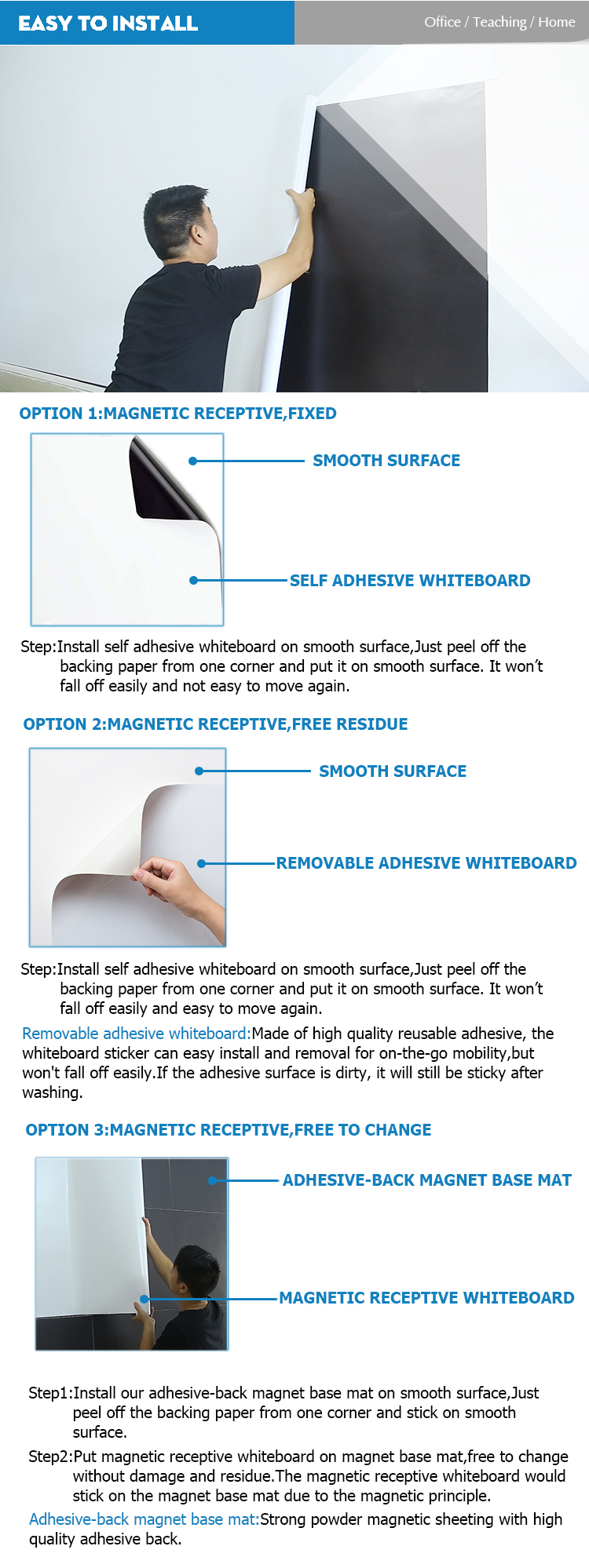
Magnetic Receptive Whiteboard Sheet
Portable Whiteboard,Magnetic Receptive Whiteboard Sheet,Rolling Whiteboard,Whiteboard Wall
Guangzhou New Magnetics Technology Co.,Ltd , http://www.softwhiteboard.com